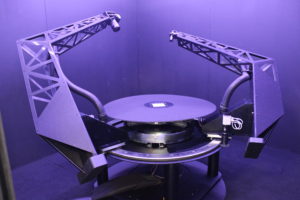
 How can you capture the visual texture of fabric for high-end, online retail? This was the challenge that fashion retail start-up Change of Paradigm and University College London (UCL) gave robotics consultancy Robotae, as part of a twelve month Innovate UK-funded project.
How can you capture the visual texture of fabric for high-end, online retail? This was the challenge that fashion retail start-up Change of Paradigm and University College London (UCL) gave robotics consultancy Robotae, as part of a twelve month Innovate UK-funded project.
Change of Paradigm is developing a retail platform, miximaliste.com, offering high-end ladies’ fashion by selling exclusively from photorealistic 3D-simulated garments before they’re produced, eliminating over-production and reducing supply-chain costs.
In this early stage of the programme, Robotae has designed a gonioreflectometer to take images of textile samples from different angles, illuminated from many directions to characterise their reflectance. By gathering these visual properties, the eventual 3D rendered images will display accurate texture and movement of the materials. Robotae designed and built the device, including construction of a purpose-built darkroom to house the system.
The device moves a digital camera to any position around the textile sample; a high quality spotlight is independently moved around the sample, providing uniform illumination from any direction. Capture sessions can involve tens of thousands of images, so speed is of the essence. To achieve this without resulting in blurred images, very smooth movements (jerk-limited motion) are used on each axis, so no settling delay is necessary at the end of each movement. The system stands on vibration isolating mounts to further remove blur.
The machine follows a scripting language to automatically capture a large number of images at up to one image every 1.6 seconds. The longest run to date is 10,000 images, with scripts of up to 26,000 images planned later in the research programme. The images are captured over USB 3 using the Canon EDSDK API and streamed onto a solid state hard drive, which is then sent to a team at UCL. Using a high-performance computing cluster they are able to extract the particular properties of the materials that are needed for state-of-the-art rendering.

Prof Tim Weyrich, UCL (Credit – University College London)
Tim Weyrich, Professor of Visual Computing at UCL, is a specialist in the measurement and acquisition of surface reflectance of complex materials and is leading the UCL team.
“Most gonioreflectometer designs would put the textile sample on a turntable, so you could avoid rotating your camera around it,” says Tim. “We had to do this in a more sophisticated way, as when you are photographing a delicate structure, it can change the moment you move it. So it was very important that the sample we imaged was motionless and static.”
When it came to implementing this unique design, he found it difficult to find a development partner who met all the requirements.
Tim explains: “We were looking for a unicorn. It was quite difficult to find someone with a good understanding of the scientific approach, mechanical engineering, electrical engineering, computer science and with the capability of communicating on an abstract and detailed level for the final specification.
“Most potential partners specialised in either robotics or cameras alone, but Robotae knew how to do both.”
Tim continues: “The gonioreflectometer is a flexible proof of concept, standing with one foot in the domain of academic research, where there are a lot of unknowns. We chose Kevin due to his comprehensive experience, scientific background and understanding of working with academia.”
Click here to watch a video of the gonioreflectometer in action on the case study page.